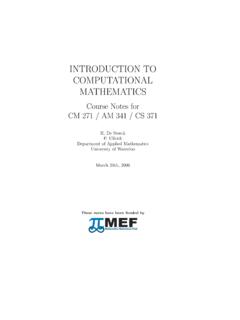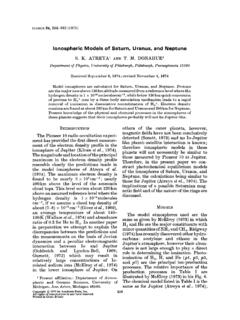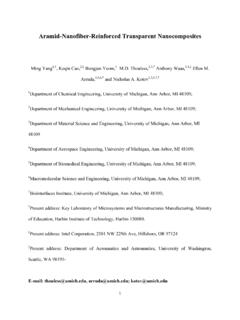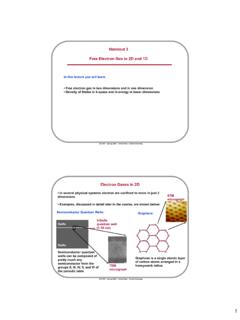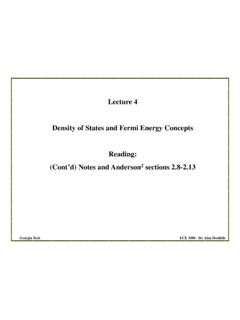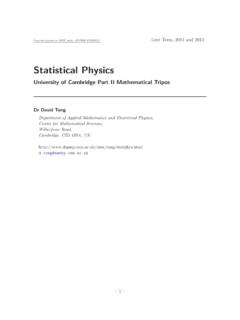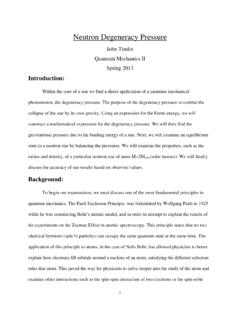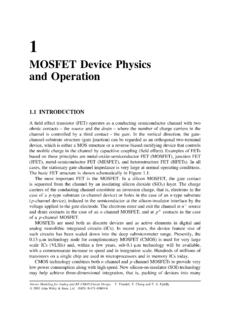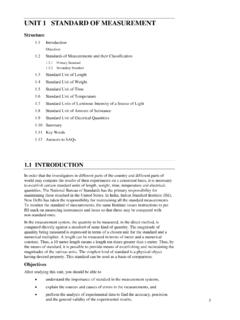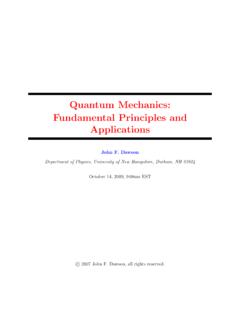Transcription of Free Electron Fermi Gas - University of Michigan
1 33. 6. free Electron Fermi Gas Electrons in a metal Electrons in one atom One Electron in an atom (a hydrogen-like atom): the nucleon has charge +Z e, where Z is the atomic number, and there is one Electron moving around this nucleon Four quantum number: n, l and lz , sz . energy levels En with n = 1, 2, 3 .. Z2 e4 1. En = - ( ). 32 0 n2. 2 2 2. where = me m N Hme + m N L me where me is the mass of an Electron and m N is the mass of the nucleon. eV L Z2. En = - ( ). n2. For each n, the angular momentum quantum number [L2 = lHl + 1L ] can take the values of l = 0, 1, 2, 3, 4 , n - 1. These states are known as the s, p, d, f , g, states For each l, the quantum number for Lz can be any integer between -l and +l Hlz = -l, -l + 1, , l - 1, lL. For fixed n, l and lz , the spin quantum number sz can be +1/2 or -1/2 (up or down).
2 At each n, there are 2 n2 quantum states . In a real atom In a hydrogen-like atom, for the same n, all the 2 n2 quantum number has the same energy . In a real atom, the energy level splits according to the total angular momentum quantum number l. Typically, the state with lower l has lower energy (not always true). Due to the rotational symmetry, states with the same l has the same energy (if we ignore the spin-orbital coupling, etc.).. n=4 l=1 4s 2. n=3 l=2 3 d 10. n=3 l=1 3p 6. n=3 l=0 3s 2. n=2 l=1 2p 6. n=2 l=0 2s 2. n=1 l=0 1s 2. 34 Many electrons at T = 0. Electrons are fermions. The Pauli exclusive principle requires that we can have at most 1 Electron per quantum state. At T = 0, to minimize the total energy , the electrons want to state at the lowest Ne quantum state.
3 Ne Element No. of electrons on each shell 1 H 1 s1. 2 He 1 s2. 3 Li 1 s2 2 s1. 4 Be 1 s2 2 s2. 5 B 1 s2 2 s2 2 p1. 6 C 1 s2 2 s2 2 p2.. 10 Ne 1 s2 2 s2 2 p6. 11 Na 1 s2 2 s2 2 p2 3 s1. 12 Mg 1 s2 2 s2 2 p2 3 s2.. Valence electrons Electrons in the low energy states (inner layers) are bonded tightly to the nucleon. (It costs about 1-10 eV to remove one of these electrons from an atom. 1eV is 104 K. It is a very high energy cost in solid state physics). Electrons in high energy states (outer layers) are loosely bonded to the nucleon (easy to remove). These electrons are called the valence electrons and these energy states are called the valence shells. Valence electrons are the electrons in a atom which can participate in the formation of chemical bonds.
4 They are typically electrons in the outermost (or second-outer-most) shell. Electrons in a metal In a metal, an atom may lose some or all of its valence electrons and thus turns into an ion (nucleon+inner electrons). These ions form a crystal and their motions are phonons. The valence electrons are no longer bonded to nucleons. They can move freely in a crystal. A crystal = A lattice of ions + valence electrons ( ). Motions in a crystal = phonons + valence electrons ( ). At low temperature, the interactions between phonons are typically very weak. So we can consider treat them as a quantum gas (a Bose gas). In a metal, because valence electrons can move around, we can treat them as a quantum fluid (a fermion fluid). Typically, we call this fluid a Fermi liquid.
5 It is called a Fermi liquid, instead of a Fermi gas, because the interactions between electrons (Coulomb interactions) are typically pretty strong (comparable to the kinetic energy in most metals). A solid can be considered as the mixture of two type of fluids: A Bose gas of phonons + A Fermi liquid of electrons ( ). free electrons in 1D at zero temperature T = 0. Here, we start from the simplest situation: a free Fermi gas The word free here means two things. 1. We ignore interactions between electrons 2. We ignore interactions between electrons and ions (nucleons). Within this approximation, electrons are free particles. So their Hamiltonian is (for a 1D system). p2 1 2 2 2. H= = - =- ( ). 2m 2m x 2 m x2. One Electron in 1D. The Schrodinger equation is 35.
6 N HxL = n HxL. 2 2. - ( ). 2 m x2. The solutions of this equation are plane waves n HxL = A expH kn xL ( ). The eigen- energy n is 2 kn 2. n = ( ). 2m For a 1D system with length L and periodic boundary conditions, n HxL = n Hx + LL, we know that the wavevector (momentum) is quantized kn L = 2 n ( ). with n being an integer, n = , -2, -1, 0, 1, 2, Or say, . kn = 2 n ( ). L. The eigen- energy here is also quantized 2 kn 2 2 2n 2. n = = ( ). 2m 2m L. For a large system L , the energy and momentum become continuous variables. Many electrons in 1D at T = 0. At T = 0, the electrons want to stay in the lowest energy states to minimize the energy . But electrons are fermions, which means that they cannot all just go to the lowest energy state 0 . Due to the Pauli exclusive principle, one quantum state can host at most one Electron .
7 These means that for each n, we can have at most two electrons (one with spin up and one with spin down). If we have N electrons, at T = 0, the Electron occupies the lowest N 2 states . The energy of the highest filled state is known as the Fermi energy F . The momentum of this state is known as the Fermi momentum PF . The wavevector of this state is known as the Fermi wavevector kF . Obviously, PF 2 2 kF 2. PF = kF and F = = ( ). 2m 2m For a large system (L ), F = ? The number of quantum state between -PF to PF is (the factor 2 comes from the spin degrees of freedom): P 2L L 2L. 2 . PF PF. = P= 2 PF = PF ( ). - PF 2 2 - PF . L. Number of electrons in these states 2L. Ne = PF ( ).. So Ne Ne PF = = ( ). 2L 2 L. Here Ne L is the density of electrons (number of electrons per length).
8 PF 2 2 2 Ne 2. F = = ( ). 2m 8m L. The bottom line: PF , F and kF are determined by the density of electrons. 36 free electrons in 1D at finite temperature Distribution function The distribution function f H L measures the average number of electrons on a quantum state with energy . At zero temperature, the number of electrons on a quantum state is 1 if < F and 0 if > F . In other words, this function is a step function f H L = : 1 < F. ( ). 0 > F. At finite T, the Electron number on a quantum state is NOT fixed. Sometimes this state is occupied (1 Electron ) and sometimes it is empty (0. Electron ). So the average Electron number is some number between 0 and 1. 0 < f H L < 1 at finite T ( ). Fermi distribution: For non-interacting fermions, at finite temperature, the distribution function takes this form f H L =.
9 1. N+1. - ( ). expJ. kB T. where is known as the Fermi -Dirac distribution. Let's compare it with the Planck distribution (for phonons) we learned in the previous chapter. fphonon H L =. 1. N-1. ( ). expJ. kB T. We found two differences: (1) -1 turns into +1 and (2) we have an extra parameter for electrons. The 1 is determined by the nature of the particles. For bosons (photons, phonons, etc.), it is -1. For fermions (electrons, protons), it is always +1. The parameter is called the chemical potential. It is a very important parameter in thermodynamics and statistical physics (it is as important as the concept of temperature). It controls the density of particles in a system. Here, for a Fermi gas, we can consider it as a generalization of F at finite T.
10 In fact, we will show below that when T 0, F . How to determine ? The chemical potential can be determined by counting the total number of electrons f H k L =. P L 1. Ne = 2 .. 2 L. P. k2. - - - ( ). 2m exp +1. kB T. Divided by L on both sides: Ne 1 1.. = P. k2. L - - ( ). 2m exp +1. kB T. If we know the density of electrons Ne L, we can solve this equation to find . In general, depends on T and the Electron density. As T 0, F . Some properties of f H L. (a) f H L turns into a step function at T 0. - . At low T, becomes very large. Depending on the sign of - . kB T. =: - - < . LimT 0 ( ). kB T + > . Therefore, 37. 1 1. = =1 < . LimT 0 f H L = LimT 0 =: 1 expH - L+1 0+1. ( ). N+1. - 1 1. expJ = =1 > . kB T expH + L+1 0+1. This result recovers the zero temperature limit we studied above.




